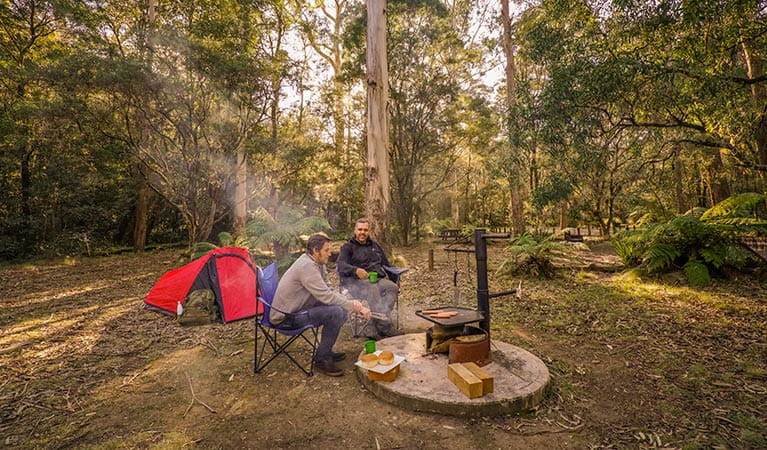Thungutti campground
New England National Park
Overview
Nestled under the shade of the tall eucalypt trees is a delightful camping area only moments from the spectacular views of Point lookout and many nearby walking tracks.
| Number of campsites | 17 |
|---|---|
| Camping type | Tent, Camper trailer site, Camping beside my vehicle Small campervans |
| Facilities | Picnic tables, barbecue facilities, carpark, toilets |
| What to bring | Firewood |
| Group bookings | Bookings for up to 5 sites and 20 people can be made online. School groups and commercial tour operators can submit a group booking enquiry form. |
| Please note |
|
Nestled under the shade of the tall eucalypt trees, you’ll find plenty of tucked away and secluded campsites to pitch a tent at Thungutti campground.
Relax and enjoy the lush greenness of scattered ferns around you, listening to the kookaburras laughing in the trees above.
Once you get settled, it’s time to explore. Tea Tree Falls walking track starts right here, taking you through tea tree woodland and across the Styx River headwaters to a forest of hanging moss. Or head off on Snow Gum walk to discover the incredible natural wonders of the ancient Gondwana rainforest.
On your return, you’ll find a barbecue shelter for cooking up a tasty dinner and a place to enjoy the warmth of the campfire. Then, snuggle up for a good night’s rest, before your sunrise visit to Point lookout.
Map
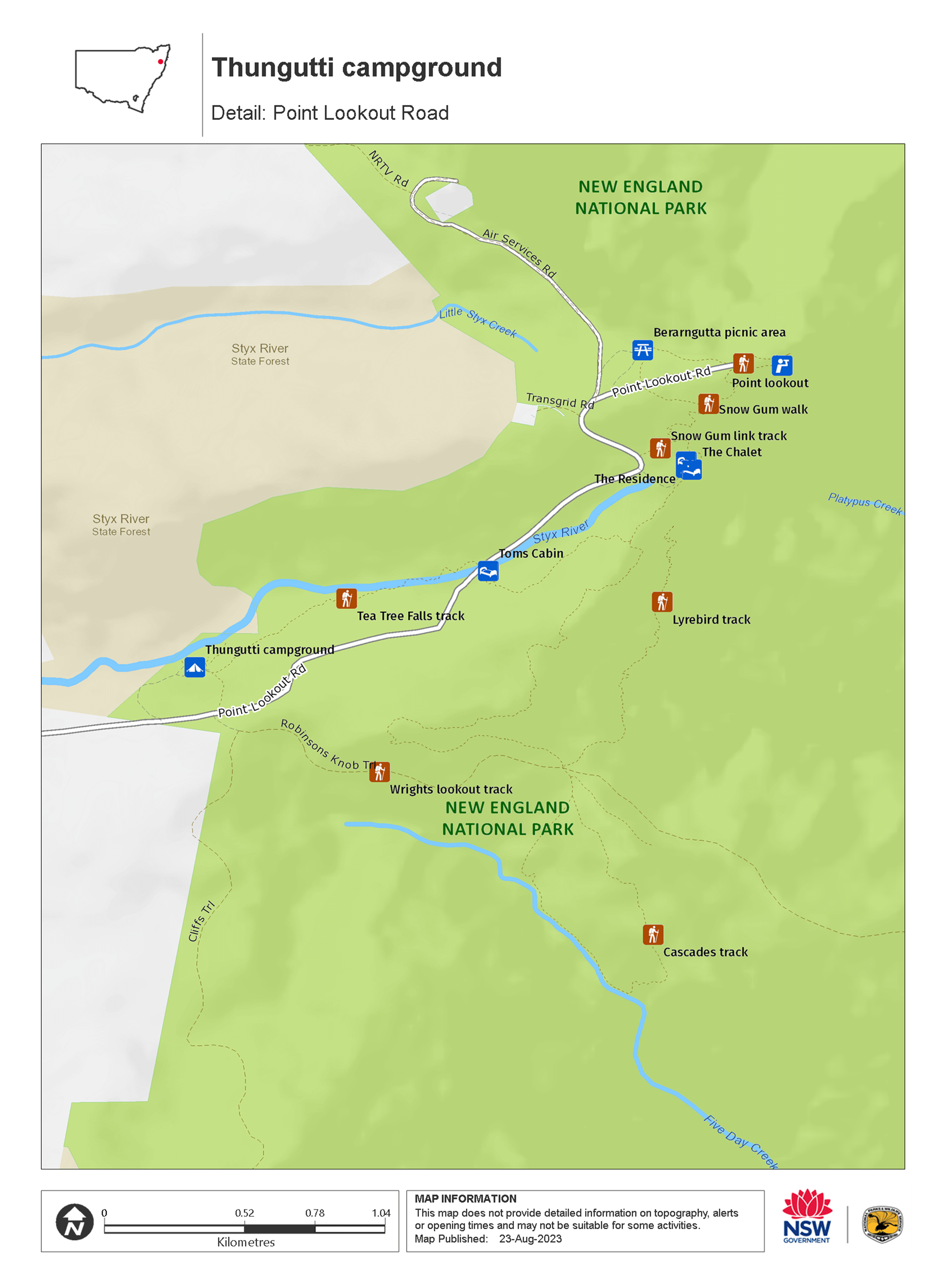
Map legend

Local alerts
For the latest updates on fires, closures and other alerts in this area, see https://www.nationalparks.nsw.gov.au/camping-and-accommodation/campgrounds/thungutti-campground/local-alerts
Bookings
- National Parks Contact Centre
- 7am to 7pm daily
- 1300 072 757 (13000 PARKS) for the cost of a local call within Australia excluding mobiles
- parks.info@environment.nsw.gov.au
Operated by
- Coffs Harbour office
- Monday to Friday, 8.30am to 4.30pm.
- 02 6652 0900
- npws.coffscoast@environment.nsw.gov.au
- 4/32 Edgar St, Coffs Harbour NSW 2450
Park info
- in New England National Park in the North Coast and Country NSW regions
New England National Park is always open but may have to close at times due to poor weather or fire danger.
Visitor info
All the practical information you need to know about Thungutti campground.
Getting there and parking
On entering New England National Park:
- Continue along Point Lookout Road
- Thungutti campground is located on your left, just near the park entrance.
Road quality
- Unsealed roads
Vehicle access
- 2WD vehicles
Weather restrictions
- 4WD required in wet weather
Parking
Parking is available in gravel carparks at Thungutti campground.
Best times to visit
There are lots of great things waiting for you in New England National Park. Here are some of the highlights.
Autumn
Enjoy the fresh air walking during the day, and cosy nights by the fire at Toms Cabin.
Spring
Climb up to Wrights lookout and see the colourful display of wildflowers.
Summer
Immerse yourself in the cool air and vibrant green of the Antarctic beech rainforest covered in moss.
Weather, temperature and rainfall
Summer temperature
Average
10°C and 24°C
Highest recorded
32.8°C
Winter temperature
Average
1°C and 12°C
Lowest recorded
-7.1°C
Rainfall
Wettest month
January
Driest month
June
The area’s highest recorded rainfall in one day
286.1mm
Facilities
- Tank water is available at this campground, but you’ll need to treat or boil it before drinking.
- There may be a supply of firewood at this campground, but it’s a good idea to bring your own supply.
- Rubbish bins are not available, so please take your rubbish with you when leaving.
Toilets
- Non-flush toilets
Picnic tables
Each campsite has a picnic table
Barbecue facilities
- Wood barbecues (firewood supplied)
- Gas/electric barbecues (free)
Carpark
Step-free access
The campground is flat and step-free. There's a paved pathway through the middle of the campground that leads to some of the picnic tables and a barbecue shelter.
To reach the rest of the campground, you'll need to cross over flat grass and gravel.
Maps and downloads
Accessibility
Disability access level - medium
Thungutti campground is mostly flat and step-free, with a paved pathway that leads through the middle of the campground to some of the picnic tables and a barbecue shelter.
There are parts of the campground where people with reduced mobility may need assistance:
- The toilets and shower are not accessible or ambulant
- Aside from the single paved pathway, there are no other paths at the campground. You'll need to cross over grass or gravel to reach the rest of the facilities.
Prohibited
Noise restrictions apply at this campground.
Gathering firewood
Generators
Pets
Pets and domestic animals (other than certified assistance animals) are not permitted. Find out which regional parks allow dog walking and see the pets in parks policy for more information.
Smoking
NSW national parks are no smoking areas.
Learn more
Thungutti campground is in New England National Park. Here are just some of the reasons why this park is special:
Aboriginal cultural heritage
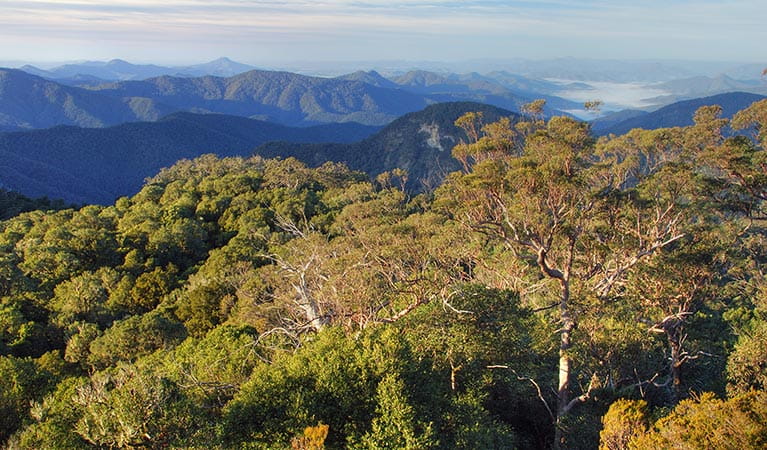
The park straddles the traditional boundaries of the Dunghutti, Anaiwan and Gumbaynggirr People, and covers an area of great spiritual and cultural significance to local Aboriginals. Point Lookout in particular is a sacred location, known to Aboriginal people as 'Berarngutta', which roughly translates as 'prohibited area'. It is considered a men-only place, and today many Aboriginal women choose to continue this tradition and avoid visiting the area.
- Point lookout Point lookout is a must-see destination for visitors to New England National Park, offering panoramic views across World Heritage rainforest to the ocean in the distance.
Amazing wildlife
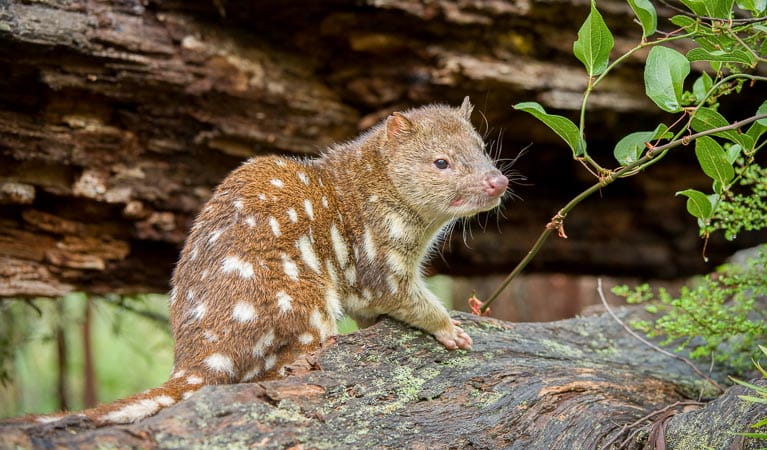
The park's altitudinal range, from 150m above sea level to 1563m, makes it a superb habitat for a diversity of wildlife. You might see kangaroos, wallabies, gliders, possums and the inquisitive spotted-tailed quoll. Adults and children alike will love watching the resident lyrebird at Banksia Point. Yet with over 100 species of birds in the park, there are plenty of opportunities for birdwatching. You might spot white-throated tree creepers and rufous fantails in the open forests, while in winter flowering banksias attract Lewins honeyeaters and eastern spinebills.
- Point lookout walking track It only takes 20 minutes to negotiate the easy Point lookout walking track, but the views from this sealed track, within New England National Park, are truly stunning.
- Wrights lookout walking track Wrights lookout walking track takes you through a lush world of ferns and wildflowers to a rocky plateau with spectacular panoramic views looking down to Bellinger River.
Historic heritage
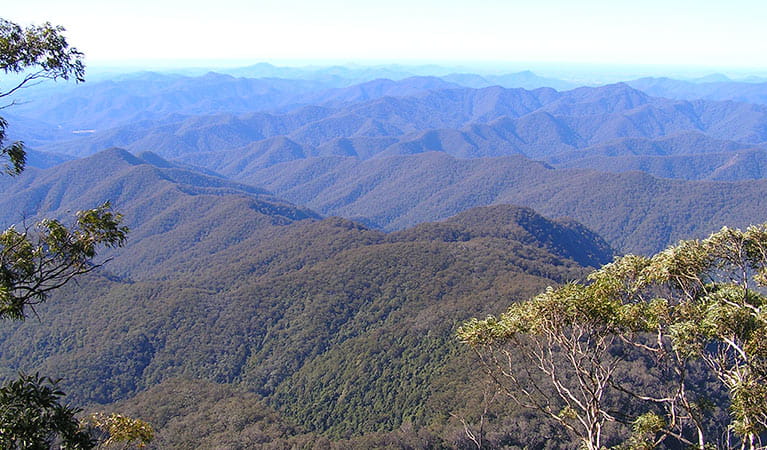
In 2010, New England National Park celebrated its 75th anniversary as one of NSW's most iconic parks. Its history is a testament to the vision and dedication of several influential New Englanders, notably Philip A Wright and his son Peter. They were deeply impressed by the beauty and grandeur of Point Lookout and recognised the value of the area as a sanctuary for plants and animals. After you see the spectacular views at Point Lookout, take a moment to learn about the history of the park and the visionary people behind its conservation.
Volcanic landscape
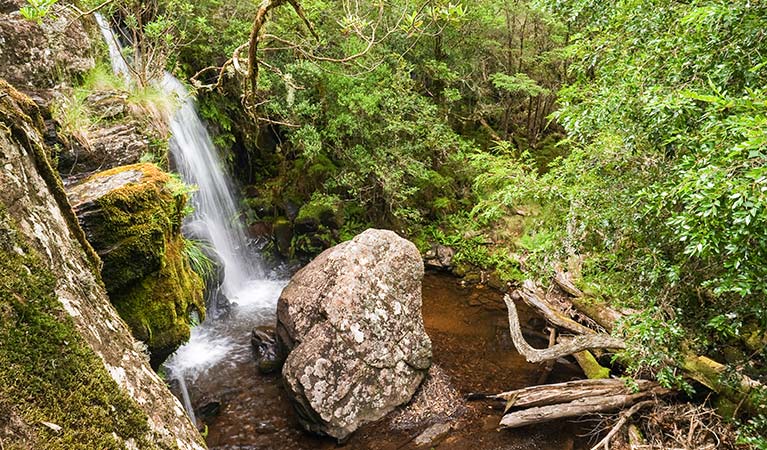
The steep cliffs of the plateau edge at New England National Park are the result of at least 5 basalt lava flows from the Ebor volcano, forming a rim over 300m thick. Active until about 18 million years ago, this massive volcano was centred around The Crescent, a semi-circular ridge in the Bellinger Valley, visible from Point Lookout. Subsequent erosion has created the dramatic profile of the escarpment we see today. The Banksia Point circuit provides a close-up view of a basalt flow, and you can see the layers of cliffs north from Point lookout.
- Point lookout Point lookout is a must-see destination for visitors to New England National Park, offering panoramic views across World Heritage rainforest to the ocean in the distance.
- Tea Tree Falls walking track Roam through eucalypt forest and beneath hanging moss on Tea Tree Falls walking track, linking Thungutti campground and Toms Cabin in New England National Park.
World Heritage rainforests
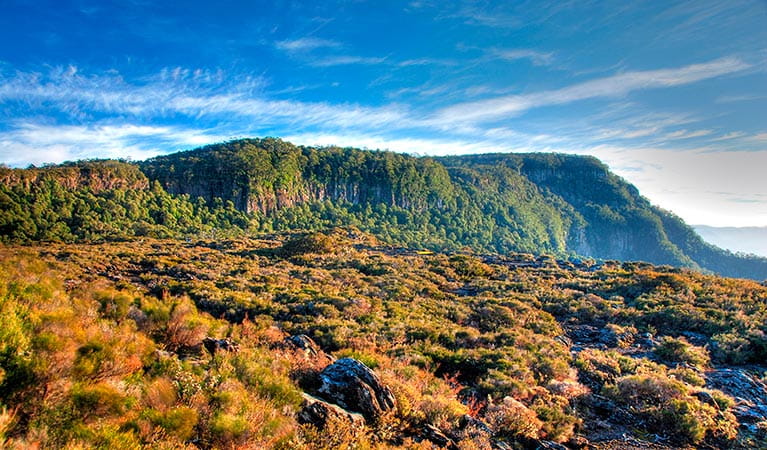
The rainforests in New England National Park are part of the Gondwana Rainforests of Australia World Heritage Area; the most extensive strip of diverse rainforest anywhere on earth. The World Heritage Area is a direct window into the past and the future, providing a link to the ancient pre-human world and a stunning and irreplaceable record of life on our planet. Discover the ancient Antarctic beech forests below the escarpment edge on trails like Lyrebird walking track.
- Snow Gum walk Snow Gum walk in New England National Park offers a scenic stroll through World Heritage rainforest. Just 1km and suitable for all ages, it’s ideal as a quick family outing.
Plants and animals protected in this park
Animals
-

Superb lyrebird (Menura novaehollandiae)
With a complex mimicking call and an elaborate courtship dance to match, the superb lyrebird is one of the most spectacular Australian animals. A bird watching must-see, the superb lyrebird can be found in rainforests and wet woodlands across eastern NSW and Victoria.
-
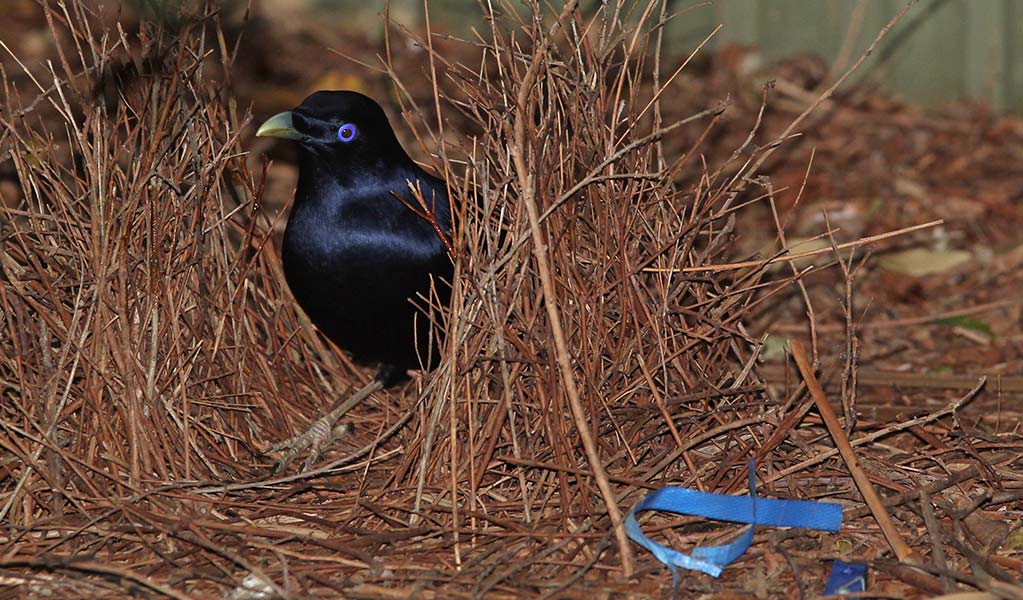
Satin bowerbird (Ptilonorhynchus violaceus)
With vibrant blue-violet eyes and curious antics, the satin bowerbird is a favourite for bird watching and easy to spot as it forages for food in open forest. Relatively common across eastern Australia, in NSW they’re found in coastal rainforests and adjacent woodlands and mountain ranges.
-
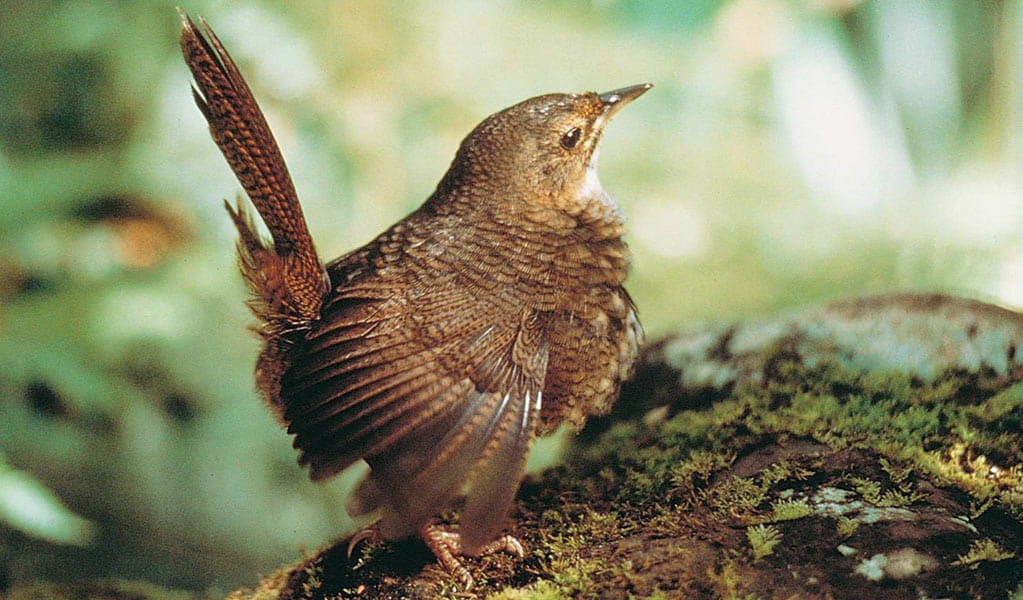
Rufous scrub-bird (Atrichornis rufescens)
The vulnerable rufous scrub-bird is a small, ground-foraging bird that lives only in isolated rainforest areas of south-eastern Australia.
-
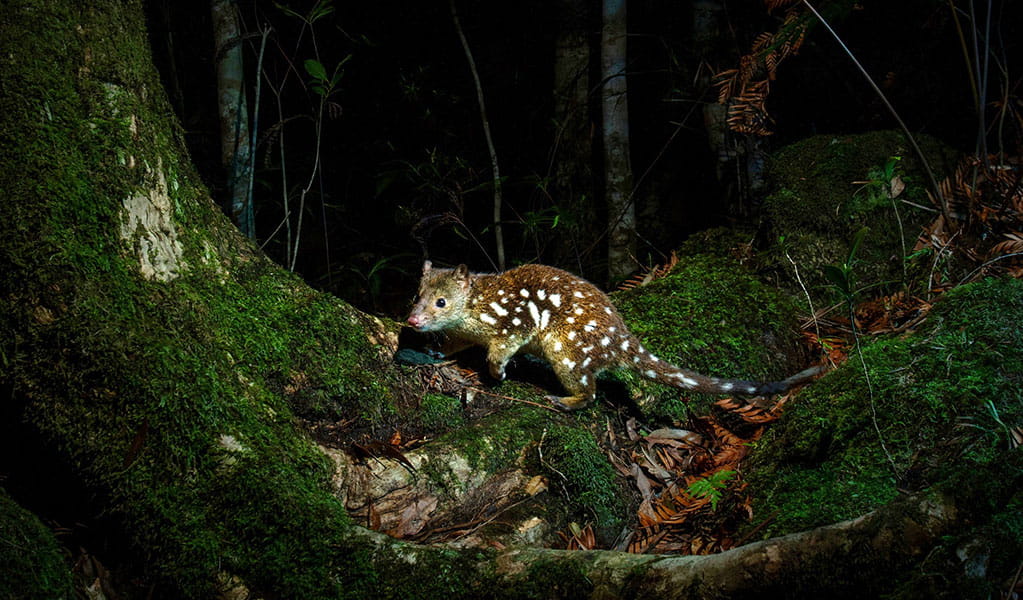
Spotted-tailed quoll (Dasyurus maculatus)
The spotted-tailed quoll is the largest remaining carnivorous marsupial on the Australian mainland. It’s protected as a vulnerable species in NSW.
Plants
-
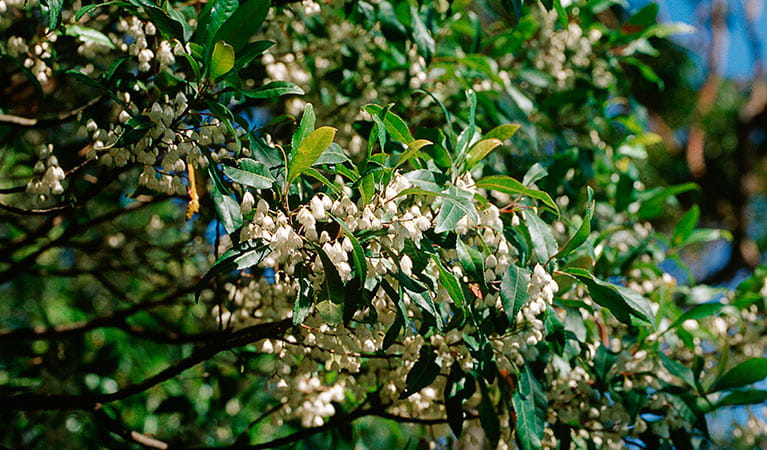
Blueberry ash (Elaeocarpus reticulatus)
The blueberry ash is a rainforest shrub which produces blue olive-shaped berries and spectacular bell-shaped flowers, which often appear on the plant together. It is a tall slender shrub or small tree found in rainforest, tall eucalypt forest and coastal bushland in eastern NSW, south-east Queensland and Victoria.
-
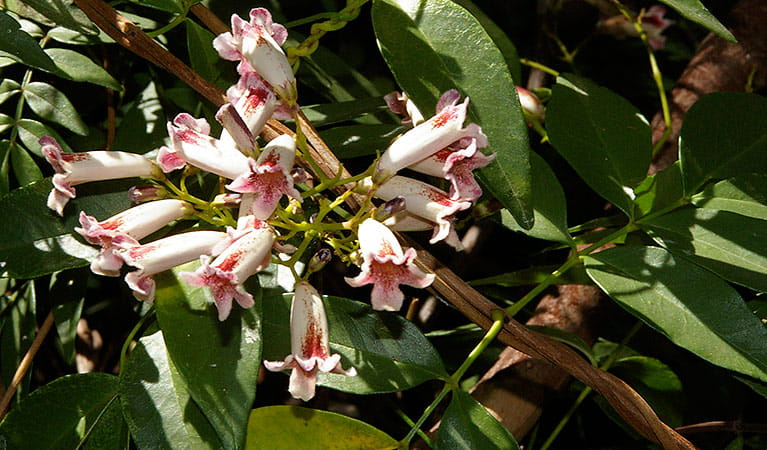
Wonga wonga vine (Pandorea pandorana)
The wonga wonga vine is a widespread vigorous climber usually found along eastern Australia. A variation of the plant occurs in the central desert, where it resembles a sprawling shrub. One of the more common Australian native plants, the wonga wonga vine produces bell-shaped white or yellow flowers in the spring, followed by a large oblong-shaped seed pod.
-
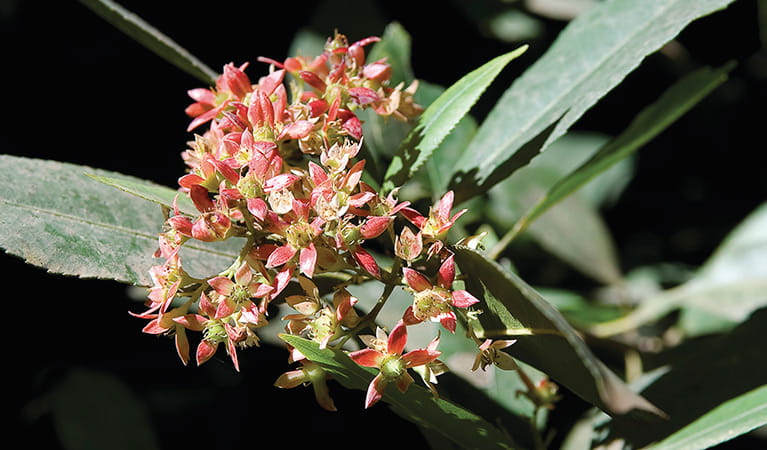
Coachwood (Ceratopetalum apetalum)
Coachwood trees are Australian native plants that grow in warm temperate rainforests along coastal NSW. Also known as scented satinwood, the mottled grey bark of the coachwood has horizontal markings and a delicate fragrance.

